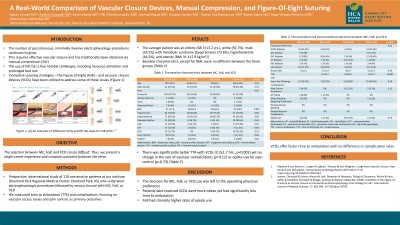Access and Closure
Comparison of Vascular Closure Device, Manual Compression, and Figure-of-Eight Stitch for Electrophysiology Procedures

Purpose: Though manual compression (MC) has remained the gold standard for achieving hemostasis, new technologies have emerged over the last 20 years. Vascular closure devices (VCDs) and the Figure-of-Eight stitch (Fo8) have shown improved efficacy in hemostasis with no significant difference in the rate of complications. We compared the real-world outcomes of MC, VCD, and Fo8.
Material and Methods: We performed a prospective study of 110 patients at our institution who underwent various electrophysiological procedures and vascular closure with MC, VCD, or Fo8. We assessed differences in ambulation and discharge times, complications, and pain control between the methods.
Results: Vascular closure with MC, VCD, and Fo8 occurred in 21.8% (n=24), 56.4% (n=62), and 21.8% (n=24) of cases. The mean age was 68.7±13.2 years and 55.5% (n=61) were men. All baseline characteristics besides a higher body mass index in the VCD group were stable. Time to ambulation between VCDs (3.2±1.7 hrs.), MC (5.2±2.7 hours), and Fo8 (4.9±2.3 hrs,) was significantly different (p < 0.001) after sheath removal. More same-day discharges were seen in patients with VCDs (40.3%, n=25) than MC (29.2%, n=7) or Fo8 (20.8%, n=5), but was not statistically significant (p=0.36). Groin hematoma occurred in those with VCDs (3.2%, n=2) and Fo8 (12.5%, n=3); AV fistula formation occurred once in MC (4.2%, n=1); bleeding requiring blood transfusion occurred once in VCD (1.6%, n=1); and those with Fo8 required greater opiate use (12.5%, n=3) than VCD (1.6%, n=1) or MC (4.1%, n=1) but not statistically significant (p=0.73).
Conclusions: There are multiple options for vascular closure following electrophysiology procedures. Our results suggest VCDs offer early ambulation with no significant differences in complication rates.
Material and Methods: We performed a prospective study of 110 patients at our institution who underwent various electrophysiological procedures and vascular closure with MC, VCD, or Fo8. We assessed differences in ambulation and discharge times, complications, and pain control between the methods.
Results: Vascular closure with MC, VCD, and Fo8 occurred in 21.8% (n=24), 56.4% (n=62), and 21.8% (n=24) of cases. The mean age was 68.7±13.2 years and 55.5% (n=61) were men. All baseline characteristics besides a higher body mass index in the VCD group were stable. Time to ambulation between VCDs (3.2±1.7 hrs.), MC (5.2±2.7 hours), and Fo8 (4.9±2.3 hrs,) was significantly different (p < 0.001) after sheath removal. More same-day discharges were seen in patients with VCDs (40.3%, n=25) than MC (29.2%, n=7) or Fo8 (20.8%, n=5), but was not statistically significant (p=0.36). Groin hematoma occurred in those with VCDs (3.2%, n=2) and Fo8 (12.5%, n=3); AV fistula formation occurred once in MC (4.2%, n=1); bleeding requiring blood transfusion occurred once in VCD (1.6%, n=1); and those with Fo8 required greater opiate use (12.5%, n=3) than VCD (1.6%, n=1) or MC (4.1%, n=1) but not statistically significant (p=0.73).
Conclusions: There are multiple options for vascular closure following electrophysiology procedures. Our results suggest VCDs offer early ambulation with no significant differences in complication rates.
